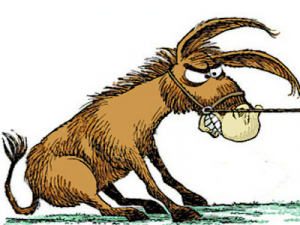
When I was a new trader many years ago, I hated being wrong with my market analysis and stock picks.
I was also quite reluctant to admit when I was wrong.
But I eventually learned there is absolutely nothing wrong with being wrong, just as long as it is done the right way. Whew! Got that?
You should love to be wrong because it means you are truly on the pathway to trading success (which is a journey, not a destination).
In this trading psychology article, I will explain the proper way to handle being wrong in trading, and why it benefits you so greatly.
Why Long Is No Longer Wrong
In my May 29 blog post, I shared my analysis on why stocks may be forming a top, despite last month’s breakout in the S&P 500.
Since then, the overall market environment has improved substantially, and all four warning signals I discussed are in the process of being invalidated (or already have been):
- Long-term T-bonds have corrected sharply (on higher volume). $TLT, for example, has already dropped back down to its 50-day moving average.
- The NASDAQ has rallied above the high of the left shoulder of its weekly head and shoulders chart pattern.
- Performance in leading stocks is improving (although leadership still primarily remains in large caps).
- Overall volume patterns are improving, meaning stocks are starting to show more convincing signs of institutional accumulation.
Given that stocks are blowing off all four warning signs I recently highlighted, it’s quite fair to say I was wrong in my recent bearish analysis.
Although my objective analysis was completely valid at the time I wrote it, the stock market has clearly been proving me wrong since then.
Nevertheless, I am perfectly okay with being proven wrong because I have learned to love being wrong.
If You’re Wrong, Simply Move Along
In trading and investing, you’re going to be wrong a lot (even Warren Buffett is).
But being wrong does not necessarily mean you will lose money; whether or not being wrong leads to major losses is ultimately up to you.
 When you are wrong, do you quickly realize it, admit it, and take corrective action?
When you are wrong, do you quickly realize it, admit it, and take corrective action?
Or do you let your ego rule your decision making and thereby cling to your opinion?
Being wrong is absolutely fine (get used to it), but what is not okay is staying wrong!
Sure, being right is fun and it feels good when your plan works out. After all, we’re only feeble earthlings.
Nevertheless, being a slave to your ego is one of the most detrimental mistakes a trader can make.
Regardless of whether you are right or wrong in your daily trading decisions and stock picks, it is crucial to check your ego at the office door every morning.
React, Don’t Predict
Regardless of what type of trading system you follow, one of your most important keys to success is disciplining yourself to merely react to price action, rather than attempting to predict it.
Being a reactive trader keeps you nimble like a ninja, which is of paramount importance when dealing with an increasingly dynamic stock market.
 One common mistake made by many new traders is relying on the deceiving emotion of hope.
One common mistake made by many new traders is relying on the deceiving emotion of hope.
Along with fear, greed, and regret, hope is one of the four most dangerous emotions that can destroy your ability to reap consistent trading profits.
Here is a typical example of how hope gets you into trouble…
You form an opinion of what stocks may do (nothing wrong with that part), the market proves you wrong, and then you fall into the trap of hoping you will ultimately be right and stocks will still move in your anticipated direction.
Rather than quickly cutting any losses and reacting to what is actually happening in the market, you continue to stay wrong, which in turn sends you and your trading account into a downward spiral in the blink of an eye.
Has that ever happened to you?
Way back in my formative years as a trader, it happened to me more times than I care to remember, but I eventually learned the hard way (there’s no better teacher than losing money) to simply react.
No Damage Done
Despite my recently bearish market analysis here on my blog, I want to make it clear that the model portfolio of my nightly stock and ETF newsletter is currently positioned only on the long side of the market (and has been for several weeks).
I have been long, not short, because the price action never confirmed my bearish analysis.
Practicing what I preach, I have merely been reacting to price action as it has been unfolding, and overall market sentiment has been increasingly bullish.
If you follow my blog, you need to understand that any technical analysis I share, bearish or bullish, is always subject to actually being confirmed by price before any action is taken in my stock picking newsletter.
Although there were indeed plenty of valid reasons why stocks were likely headed lower, and I was fully prepared to act on the short side if that happened, the market went the opposite direction instead.
As such, I simply avoided the short side of the market and (cautiously) followed the trend on the long side instead.
The market timing model of my Wagner Daily newsletter is now in “buy” mode, and the model portfolio is now holding a handful of stocks and ETFs (most positions presently showing unrealized gains).
If you learn to consistently trade what you see, not what you think, you will already have conquered one of the most challenging aspects of active trading.
If you found this trading psychology article to be helpful, please share this blog post with your favorite social network (click icons on left).

Great read..
Thanks, Nita. Glad you found the trading psychology article helpful.